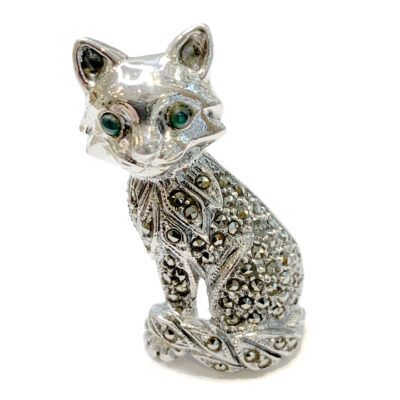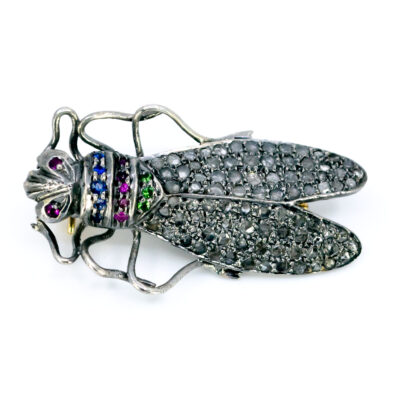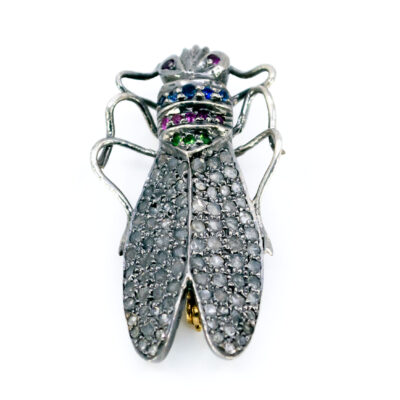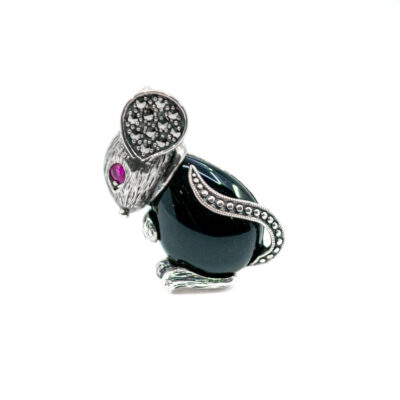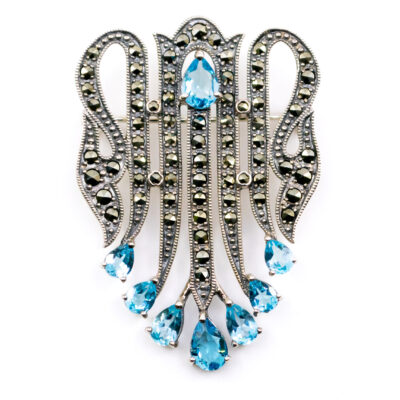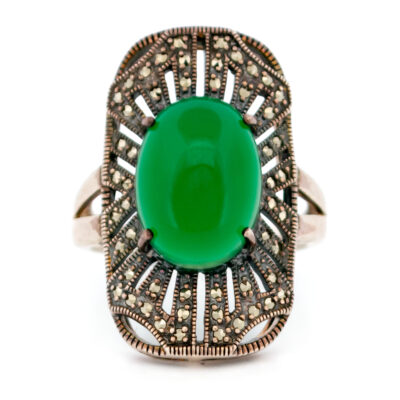A true nod to Scottish heritage, this elegant garter brooch showcases mesmerizing Montrose agate, with its natural striations of soft gray tones. Beautifully set in 835 silver, it’s a piece of timeless charm and intricate craftsmanship.
Videos
Details: Scottish Montrose Agate, Silver Brooch.
Dimensions: L x W: 4.5 x 4 cm.
Weight in grams: 20.
Condition: Very good condition – slightly used with small signs of wear.
Shipping and Pickup: This timeless piece ships from our store located in the center of Amsterdam, The Netherlands. We offer both registered shipping and local pickup at our store. In the case of local pickup, any applicable shipping costs will be refunded.
About Us: Add some sparkle to your style with Binenbaum.com. We offer a stunning selection of antique and vintage jewelry that you won’t find anywhere else. From timeless rings and dazzling necklaces to unique brooches, we have something for every taste and occasion. Visit our website today and treat yourself to a piece of history.
| Design Era | |
|---|---|
| Design & Historical Context | The Late Victorian or Aesthetic period was a time of great cultural and artistic flourishing in Europe and the United States, and this was reflected in the jewelry of the time. The Aesthetic movement, which emphasized beauty and art for art's sake, was particularly influential on jewelry design during this time. Late Victorian or Aesthetic period jewelry is known for its intricate detailing and use of precious materials such as gold, silver, and diamonds. It often featured motifs such as flowers, animals, and nature scenes, and was inspired by a variety of cultural movements, including the Arts and Crafts movement, which sought to return to traditional craftsmanship and natural materials. One of the most distinctive features of Late Victorian or Aesthetic period jewelry is its emphasis on the use of enamel. Enamel is a type of glass-like material that is fused to a metal surface, and it was often used to add color and detail to jewelry. The French firm, Cartier, was particularly known for its use of enamel in its Late Victorian or Aesthetic period pieces. Late Victorian or Aesthetic period jewelry remains popular and is highly collectible to this day. It is often associated with the elegance and refinement of the time period, and is often seen as a symbol of wealth and sophistication. |
| Key Materials | |
| Materials & Craftsmanship | Agate: The Stone of Stability and Grounding Agate is a gemstone celebrated for its rich patterns and soothing colors, making it a symbol of stability, strength, and grounding. This variety of chalcedony is known for its wide range of colors and distinctive banded patterns, which are formed by layers of mineral deposits over time, creating a unique and mesmerizing effect. Historically, agate has been valued for its protective and healing properties. Ancient civilizations, including the Greeks and Egyptians, believed agate could ward off evil and bring balance to the wearer. It was often used in amulets, seals, and talismans for its supposed ability to calm the mind, protect against danger, and promote inner stability. In modern jewelry, agate is prized for its versatility and natural beauty. Its durability, with a Mohs hardness of 6.5 to 7, makes it suitable for a wide range of jewelry pieces, from rings and necklaces to bracelets and earrings. Agate is often cut into cabochons or beads to showcase its intricate patterns and is commonly used in both contemporary and vintage-inspired designs. Agate is more than just a gemstone; it is a symbol of grounding and stability, offering a connection to the earth and a sense of balance. Its natural beauty and variety of colors make it a versatile and meaningful choice for jewelry that is both aesthetically pleasing and deeply symbolic. Silver: The Metal of Elegance and Versatility Silver, known for its bright, reflective luster, is one of the most beloved and widely used precious metals in the world. This versatile metal has been cherished for thousands of years, not only for its beauty but also for its malleability, making it ideal for crafting intricate and delicate jewelry designs. Historically, silver has been associated with the moon and considered a symbol of purity, clarity, and protection. Ancient civilizations, from the Egyptians to the Greeks and Romans, valued silver for its beauty and used it to create coins, jewelry, and religious artifacts. In many cultures, silver is also believed to have healing properties, often used in amulets and talismans to ward off negative energy. In modern jewelry, silver is prized for its affordability, versatility, and timeless appeal. Sterling silver, an alloy of 92.5% pure silver and 7.5% other metals (usually copper), is the standard used in high-quality jewelry. Its durability and bright, reflective surface make it an excellent choice for a wide range of designs, from minimalist pieces to ornate creations. Silver can be polished to a high shine or given a matte, oxidized, or antiqued finish to suit various styles. Silver is more than just a metal; it is a symbol of elegance, flexibility, and understated luxury. Its enduring popularity and wide-ranging applications make it a staple in jewelry that can complement any look, from casual to formal, with timeless grace. |
| Dimensions | L x W: 4.5 x 4 cm |
| Gender | |
| Weight (in grams) | 20 |
| Condition | Very good condition – slightly used with small signs of wear |
By following these tips, you can enjoy your precious jewelry for many years to come.
Related Products
-
Agate Marcasite (Pyrite) Silver Cat Brooch 14273-1572
€ 165,00 VAT incl. (where applicable) -
Garnet Pearl Agate Marcasite (Pyrite) Silver Floral Brooch 13121-1178
€ 395,00 VAT incl. (where applicable) -
Diamond Emerald Ruby Sapphire 14k Silver Insect Brooch 12262-7393
€ 1.295,00 VAT incl. (where applicable) -
Marcasite (Pyrite) Onyx Ruby Silver Mouse Brooch 16227-2515
€ 195,00 VAT incl. (where applicable) -
Topaz Marcasite (Pyrite) Silver Deco Brooch 13118-1175
€ 295,00 VAT incl. (where applicable)
- Home
- Collection
- Fine Jewelry
- Silver Jewelry
- Silverware
- Boxes
- Candlesticks
- Salt and pepper shakers
- Miniatures
- Salt cellars
- Spoon Set
- Condiments
- Frames
- Napkin Ring
- Spoon
- Oddities
- Cups
- Vases
- Cutlery
- Serving Spoon And Cake Server
- Candlesticks
- Baskets
- Hanukkiah
- Spice Tower
- Yad
- Tea Set
- Sugar Castor
- Napkin Rings
- Wine Bottle Coaster
- Wine Stopper
- Tea Pot
- Jugs
- Rattles
- Hip Flask
- Miscellaneous
- Rings 💍
- About
- Contact



